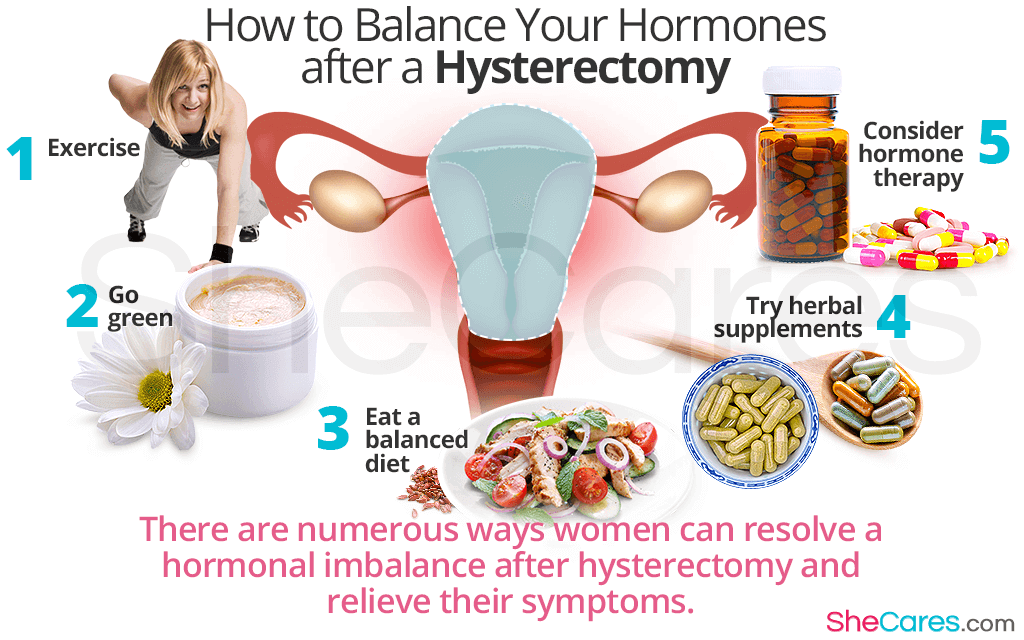While a hysterectomy, or uterus removal, alone does not immediately trigger menopause, women who had it may suffer from hormonal imbalance and tend to enter natural menopause sooner.1
Conversely, those who had their uterus removed along with the ovaries (oophorectomy) will begin menopause right after the surgery. In both cases, putting efforts into regulating hormone levels and relieving symptoms of an imbalance is key.
Read on for the best tips on how to balance hormones after a hysterectomy so that you can ease your passage through this life phase and come out of it healthier and more empowered!
Exercise
Once you're cleared by your doctor, getting back into your workout routine can be highly beneficial for balancing hormones after a hysterectomy. Staying active can help improve mood, build muscle mass, maintain bone strength, and prevent weight gain, which women after a hysterectomy are more likely to experience.2 Keep exercise at moderate intensity for a total of 150 minutes per week, divided into short, daily workouts.3
Go green
Try to stay away from xenoestrogens, known as endocrine disruptors. These chemicals are found in many everyday items, from cosmetics to plastic food containers. They mimic the body's estrogen and alter its functions, thus worsening an imbalance.4 While it's nearly impossible to entirely eliminate them from life, limiting your exposure to xenoestrogens and opting for organic options can prevent troubles on your path to resolving hormone imbalance after hysterectomy.
Eat a balanced diet
Another important approach to balancing hormones after hysterectomy is through a nutritious and well-balanced menopause diet. To give the body the nutrition it needs, promote optimal hormone levels, and prevent weight gain, make sure to include ample amounts of fresh fruits and vegetables alongside lean protein and whole grains. Also, load up on foods rich in phytoestrogens, like soy or flax, since they can help tackle hormonal imbalance and relieve symptoms.5
Try herbal supplements
Herbal supplements are a great complement to the aforementioned daily practices. You may choose between two types: phytoestrogenic supplements, like black cohosh, which contain plant compounds that mimic the body's estrogen and fill in the hormonal gap short-term, or hormone-balancing supplements, like Macafem, which stimulate the endocrine glands to improve their own hormone production long-term, without having to add outside hormones.
Consider hormone therapy
As much as a woman might want to balance hormones after a hysterectomy with oophorectomy the natural way, sometimes her symptoms are so severe that her doctor might suggest hormone replacement therapy (HRT). These medications can effectively regulate hormones, quickly relieve symptoms, and prevent osteoporosis. However, HRT is not for everyone as it has been found to come with serious health risks, like stroke or cancer.6
Conclusions
Just as every woman's menopause is different, her body's recovery after a hysterectomy will bring on experiences that are unique to her. While the above-mentioned tips on how to balance hormones after a hysterectomy can help many women adjust to the changes more quickly, it is important to listen to one's body in order to know it needs. A good way to start is by further exploring effective hormonal imbalance treatments that might ease the transition into the twilight years in a happier and healthier way!
Sources
- Cancer Epidemiology, Biomarkers & Prevention. (2007). Association of Physical Activity with Reproductive Hormones: The Penn Ovarian Aging Study. Retrieved February 26, 2020 from https://cebp.aacrjournals.org/content/16/10/2042
- Mayo Clinic. (2020). Vaginal hysterectomy. Retrieved February 26, 2020 from https://www.mayoclinic.org/tests-procedures/vaginal-hysterectomy/about/pac-20384541
- Office on Women's Health. (2019). Hysterectomy. Retrieved February 26, 2020 from https://www.womenshealth.gov/a-z-topics/hysterectomy
- Women in Balance Institute. (2012). Xenoestrogens - What are they? How to avoid them. Retrieved February 26, 2020 from https://womeninbalance.org/2012/10/26/xenoestrogens-what-are-they-how-to-avoid-them/
Footnotes:
- Obstetrics & Gynecology. (2011). Effect of Hysterectomy With Ovarian Preservation on Ovarian Function. Retrieved February 26, 2020 from https://www.ncbi.nlm.nih.gov/pmc/articles/PMC3223258/
- International Journal of Obesity. (2013). Body mass index following natural menopause and hysterectomy with and without bilateral oophorectomy. Retrieved February 26, 2020 from https://www.ncbi.nlm.nih.gov/pubmed/23007036
- Journal of Mid-Life Health. (2011). Exercise beyond menopause: Dos and Don'ts. Retrieved February 26, 2020 from https://www.ncbi.nlm.nih.gov/pmc/articles/PMC3296386/
- Environmental Health. (2012). Environmental exposure to xenoestrogens and oestrogen related cancers: reproductive system, breast, lung, kidney, pancreas, and brain. Retrieved February 26, 2020 from https://www.ncbi.nlm.nih.gov/pmc/articles/PMC3388472/
- Frontiers of Neuroendocrinology. (2010). The pros and cons of phytoestrogens. Retrieved February 26, 2020 from https://www.ncbi.nlm.nih.gov/pmc/articles/PMC3074428/
- The Lancet. (2019). Type and timing of menopausal hormone therapy and breast cancer risk: individual participant meta-analysis of the worldwide epidemiological evidence. Retrieved February 26, 2020 from https://www.thelancet.com/journals/lancet/article/PIIS0140-6736(19)31709-X/fulltext
